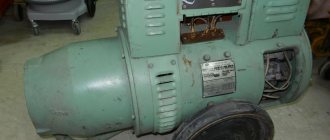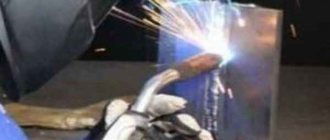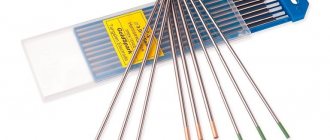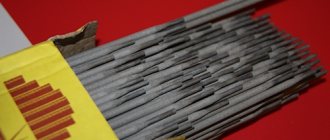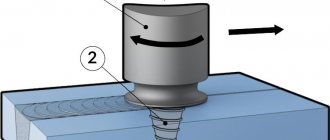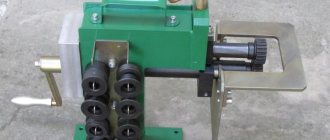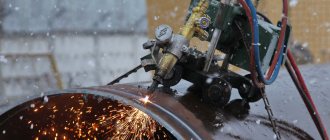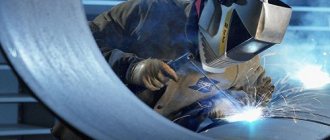What is an electric or gas welding station? Simply put, this is a welder’s workplace, which is fully equipped with the necessary equipment, apparatus, tools and consumables. There should also be an exhaust hood to remove all kinds of gases that accompany the welding process; these are safety requirements. A workbench, chair and other workshop attributes are required.
Basic equipment
To fully equip a welding station, it is necessary to equip it with electrical equipment, additional equipment and auxiliary means:
- a current source for the formation of a welding arc, which is a welding transformer or inverter;
- current-carrying cables in a reliable braid that can withstand high current strength and constant mechanical stress.
- conductors must have appropriate fastening at the end for connection to terminals, electrode holders and ground;
- gas burners for working with gas welding equipment;
- fixtures and other tools for welding work: clamps, clamps, holders;
- welding table;
- protective equipment: heat-resistant suit, special gloves, welder’s mask, headdress with a lapel.
A distinctive feature of a mobile welding station is that it does not have any boundaries. This is explained by the fact that a specialist needs to constantly move to perform his duties within a certain area: construction site, welding shop, production site, etc.
It is worth paying attention to the fact that this classification relates exclusively to the organization of procedures, but does not in any way regulate the nature of the manipulations performed.
Scheme and basic tools
The order in which equipment and fixtures are placed is dictated by the type of welding location.
For mobile post
When creating mobile workplaces, there are no special requirements for space and ventilation. However, basic safety rules should be followed:
- The trolley for placing devices and tools is equipped with wheels, ensuring ease of transportation. For work, a welding unit with a set of cables is used.
- The mobile post is equipped with stands on which a canopy is installed in case of bad weather.
- Tools are placed in special boxes.
- To protect others from light exposure, portable shields are used.
- When laying long communication lines, workplaces are equipped in trailers with autonomous generators.
For landline
When equipping a welding station in a workshop, it is necessary to purchase all the necessary equipment for the work. The list can be expanded, but when connecting metal parts you cannot do without:
- welding unit;
- a box for storing electrodes and other auxiliary tools;
- constant current source;
- convenient landing place;
- switch for supplying and disconnecting voltage;
- exhaust chamber;
- baskets, shelves and drawers for storing small tools;
- electric holder.
When placed correctly, all these devices do not take up much space.
Workplace arrangement options
In practice, it is customary to distinguish between two types of welding stations. Stationary is mostly used for working with small-sized workpieces. The mobile one is in demand at large production sites, in the construction or laying of various types of pipelines.
Basic requirements for organizing a workplace for welding work:
- Good lighting should be provided in the area. The minimum value is 80 Lux. It is advisable to combine natural light and artificial light.
- All electrical equipment must be grounded.
- The base must be strong and solid. As a rule, this is concrete or brickwork.
- Work pockets should be provided at the workplace where documentation or graphic materials could be stored.
- Good ventilation must be provided.
- The working surface of the welding table must be made of steel or cast iron. Nearby there should be connectors for connecting the welding machine and additional equipment.
- There should be a rubber mat or a thick wooden shield under the specialist’s feet.
- To perform work in a sitting position, you need a dielectric chair made of non-flammable material.
If the workplace is set up outdoors, then you need a canopy that will well protect the welder and equipment from rain. In sunny weather, you can work in an open area, but protection from direct sunlight is often required. Then the canopy can be replaced with high shields.
General and individual requirements
Regardless of the type of equipment, when organizing a post, sanitary and safety standards are observed:
- To improve the quality of welding work, provide good lighting. It should be at least 80 lux, but not interfere with the master. The lamps are installed so that no shadows fall on the desktop.
- Since welding produces vapors and gases harmful to humans, sanitary standards are taken into account when creating ventilation. Thus, exhaust equipment must cover a radius of at least 4 m, the recommended air exchange rate is more than 40 m³ per hour. When organizing a post at home, standard supply and exhaust ventilation is sufficient.
- If several craftsmen work in a room, then the installation of centralized exhaust units is required, to which all stations are connected. The dampers help regulate the air exchange rate. When working in closed containers (reservoirs, tanks), air is supplied using a mask.
- When installing single-phase welding units, an oscillator is included in the circuit. For a three-phase device, the presence of a magnetic contactor is required.
- If metal cutting will be carried out at the workplace, then a separate place will be equipped for storing and using cutting equipment.
Individual requirements are provided for different types of technologies:
- When organizing a gas welding station, a separate compartment for storing cylinders is equipped. There should be no sources of heat or open flame in the work area.
- In electrical technology, attention is paid to equipment grounding. A rubber mat is placed near the welding machine. When setting up a post on the street, a canopy is built.
- When using plasma welding, equipment is provided that quickly removes toxic products of metal combustion from the working area. There should be no flammable liquids or materials in the room.
We recommend reading: What to do if your eyes hurt from welding
What is a welding post
A welding station is essentially a makeshift welder's office. Yes, there are no comfortable chairs, tables or jugs of water, but there is everything necessary to perform a complex of welding work. In other words, a welding station is a workspace where a welder can work comfortably and safely, and he always has consumables and other necessary equipment at hand.
The welding station must be equipped in compliance with all safety and labor protection requirements. This is a mandatory condition that allows specialists to maintain their health and get the most out of them. When setting up the post, special attention is paid to fire safety. But in order to achieve all the necessary conditions, you should study the specifics of different welding posts.
Depending on the equipment used, welding stations can be:
- Gas welding . The main distinguishing principle is that the energy obtained as a result of gas combustion in a special burner is used to melt metal blanks. Due to the specific nature of gas welding, it is important to equip a good ventilation system for organizing a work office. The surface of the desktop and the space around it must be made of non-combustible materials.
- Electric welding . Working with electric welding is no less dangerous than working with gas welding. In addition to good ventilation, effective protection of employees from electric shock is also necessary.
In any case, no matter what method of welding or cutting metal is used in a closed workspace, it is very important to carefully consider the arrangement of the ventilation system. In addition to the hood, supply systems are also installed for natural or forced supply of fresh air.
Depending on the needs, welding stations can be:
- Stationary . It is a limited space in a room, equipped specifically for welding metals. They are often equipped with rotary tables for convenience.
- Mobile . They are mobile structures that one person can carry or move within the work site. The best option in cases where welding of large structures is required. They can be located indoors (workshop, production site, shipbuilding dock, etc.) or in an open area (construction, creation of large-sized non-standard structures, etc.).
A stationary welding station is best suited for joining small and medium-sized metal workpieces. But for working with large-sized structures this is not the best option. A special cabin, which serves as the “walls” of such an area, is made of galvanized metal sheets. They are characterized by high resistance to high temperatures, as well as IR radiation.
A clear advantage of a mobile welding station is the fact that there is no need to create any special conditions for work. If necessary, protection from precipitation is provided by a canopy, and from wind - by side hard screens. If conditions permit, parts are welded without protection from the weather.
Tools and additional equipment are contained in the drawers of the tool cabinet, and artificial lighting (if required) is provided locally. In mobile posts, as in stationary ones, care should be taken to ground the equipment that is connected to the power supply network.
Types of welding stations
Stationary post
The classic design of a stationary welding station involves the installation of a special protective cabin without a canopy.
Requirements for organizing a stationary workplace:
- The area of the room along the internal perimeter must be at least three square meters.
- The surface of the walls is finished with non-combustible materials.
- The cabin frame can only be made of metal.
- The height of the work table depends on the method of performing the work. For a sitting position it is 60 cm, and for a standing position it is 90 cm. Ideally, if the structure can be lowered or raised depending on the situation.
- A tarpaulin canopy is hung at the entrance.
- The minimum permissible cabin height is 2 meters.
- The lower part of the walls is raised above the floor level to improve ventilation. The gap should be at least 25 cm.
- The working surface requires a metal or cast iron sheet with a total area of at least one square meter.
- The inside of the cabin is treated with a special compound in a light gray shade. It has high fire-resistant characteristics and absorbs ultraviolet radiation. This is necessary to prevent accidental ignition of the surface of the walls of the room.
Gas welding station
To organize a gas welding station, you will first need the appropriate equipment: an acetylene generator, burners and hoses for gas supply, oxygen cylinders and reducers.
A portable gas welding station is a trolley on which cylinders, gearboxes and all the necessary equipment are located. The cart is most often made of pipes, and the wheel axle is located at the center of gravity to make it easier to move and hold.
The gas welding station equipment consists of the following elements:
- table with metal top;
- hood. It is usually installed above the table or slightly to the side;
- sources of light.
Gas cylinders are located slightly away from the workbench to prevent hot splashes from getting on the gearboxes. Gas is supplied to the work site through hoses. Large enterprises often provide for gas supply through centralized pipelines.
According to existing standards, for safety reasons, the distance between the work table and cylinders with acetylene and oxygen must be at least 10 meters. The same footage (no less!) must be maintained between cylinders and any sources of open fire. In cases where you have to work in narrow or hard-to-reach places, a supply of fresh air is required.
Mobile post
A mobile welding station is necessary when performing work with large-sized structures. Often, such a workplace is located outdoors. Therefore, it requires additional equipment for protection from sunlight, wind and precipitation. The protection consists of a hinged canopy and folding rigid shields (screens) from the wind. To accommodate consumables, additional tools and small equipment, the mobile workplace is equipped with metalwork carts with drawers.
During welding work, harmful volatile substances are released in large quantities. They pose a health hazard to the specialist. However, ventilation is not required: the mobile welding station is located in an open area and the gases quickly evaporate.
But a local lighting system may be required. In conditions of poor natural light, an additional light source will be required. It is placed directly above the table on stands. Good lighting reduces eye strain, improves working conditions, which helps increase specialist productivity. Electrical equipment, including the welding machine itself, must be grounded in order to minimize the likelihood of electric shock to the welder.
It is necessary to take into account that when installing enclosing structures, a gap of about 50 cm should be left between the panels. This is necessary to ensure a sufficient flow of fresh air. The welder must have protective equipment - a special suit, shoes, mask, mittens and headgear. It is imperative to always have a working main tool - a holder. It must be reliable and safe, protect the welder’s hand from a source of high temperature, hold well and quickly release the electrode.
Proper equipment of a mobile welding station gives the welder the opportunity to work without discomfort and in completely safe conditions. This in turn brings:
- good final result of the work;
- reducing the time required to complete welding work;
- reducing the likelihood of specialist illness.
Respiratory and skin protection
Semi-automatic welding machine Resanta Saipa 165: description and reviews
An arc is formed during welding work. It causes the following effects:
- Light, as the arc becomes a source of a bright flash.
- Ultraviolet. Such exposure causes pain and stinging in the eyes, and in some cases, skin burns.
- Infrared radiation causes cataract damage.
In addition, harmful gases may be released, which, if ingested, can lead to headaches, vomiting and weakness. Some harmful substances can accumulate in tissues, leading to the development of diseases.
Respiratory and skin protection
The most widely used means of respiratory and skin protection are:
- Special welding masks. They protect the face from splashes of hot metal, as well as the eyes from bright light sources. There are a wide variety of masks available on sale; they are selected depending on the conditions in which welding is carried out and the preferences of the welder.
- Installation of a local ventilation system that provides air supply and exhaust. A similar system is required when welding is carried out indoors.
- In some cases, respirators and gas masks are required.
- In some cases, toxic consumables are replaced with safer ones.
- The automation and mechanization of the process is significantly increased when using various devices.
Protective equipment for welding work
You need to pay attention to choosing quality protection. This is due to the fact that there are a large number of low-quality products on sale.
Safety precautions during welding work require the mandatory use of protective masks.
Welding station equipment
Regardless of the functionality, be it a stationary or mobile welding station, the specialist’s place of work must fully comply with the following set of requirements:
- grounding of all energy-consuming devices is mandatory;
- good degree of illumination of the desktop. A combination of natural and artificial lighting is considered optimal;
- floors must be made of brick or concrete;
- the table top is made of cast iron or steel and is connected to ground;
- Drawers are provided for storing tools;
- in cases where sedentary work is required, a chair made of dielectric material is required;
- A rubber mat is spread under your feet.
When working in an open area, additional protection from sunlight, wind and precipitation will be required.
Stationary station equipment
A stationary workplace must meet a number of requirements:
- Such a workplace is made in the form of a cabin that does not have a roof. The total area of the allocated space should not be less than 3 square meters. The optimal height of the fences is 2 m. The entrance opening should be covered with a canopy made of fire-resistant tarpaulin.
- The lower part of the fence should be raised above the floor to a height of 25-30 cm.
- The material for the worktop tabletop can be steel or cast iron. The surface area is made no less than a square meter.
- It should be possible to adjust the height of the table so that the welder can change it to work while sitting (50-60 cm) or standing (90 cm).
- The perimeter walls are made of fire-resistant material. On the inside they are painted a light gray shade that absorbs ultraviolet radiation.
- It is necessary to provide a hood that would effectively remove combustion products. For effective air exchange, fresh ventilation will be required. According to safety requirements, the productivity of such a system is calculated to be no less than 40 cubic meters of air per hour.
- The standard lighting brightness is 60-80 lumens. It is ideal if it is possible to provide a combined illumination of the post: natural in combination with artificial.
All equipment connected to the power supply network must be grounded. In addition, one general switch is installed, which allows you to disconnect all equipment from the supply network at once.
Mobile post equipment
An excellent option for a production workshop or other large workspace, as well as when creating large-scale structures.
Primary requirements:
- Electric welding and additional equipment are combined on a mobile cart.
- The length of the power cable must be sufficient to move within the work area or facility.
- There is no need to install a ventilation system. On the street, combustion products of consumables are carried away as a result of the natural movement of air masses.
- The portable post is equipped with a canopy and protective shields that can be quickly assembled to protect from precipitation, wind or sun.
- In the same way, it is necessary to provide for the possibility of installing fences to protect bystanders from flashes of the welding arc.
- For ease of work, the welder must have a sufficient number of tool carts to store his equipment, additional equipment and equipment.
Desktops
Considering that small metal parts are welded at stationary work stations, special tables are provided for convenience. Structurally, industrial workbenches are designed for work in a standing or sitting position. If the table is made independently, then you need to take into account that the optimal height for working while sitting is 60 cm, and for standing – 90 cm.
The table cover is made of sheet steel or cast iron 2 cm thick. The total surface area is at least 1 square meter. It is important that the table has drawers in which the welder can store electrodes and other consumables, tools and small equipment. If there are none, then you need to additionally acquire a special plumbing trolley.
Rubber mats should be placed under the table itself and along its perimeter to prevent electric shock to the welder. And one more small touch - a metal chair with a dielectric seat, which allows you to do part of the work in a sitting position.
Equipment for different types of welding
The organization of welding stations is associated, first of all, with the parameters of the equipment being used. The main ones are weight and requirements for the power supply network.
The welding station must be equipped not only with welding equipment and accessories for it. In addition, additional tools are required for trouble-free operation of welding machines, and, if necessary, minor repairs. For uninterrupted operation, you will also need a certain supply of consumables: various types of additives, flux in powder form or inert gas.
Technological maps, individual regulations, diagrams, drawings and other documentation will help you assemble a workstation more accurately. It is customary to distinguish two large groups of common equipment: electric and gas.
Stationary posts focused on the use of electrical equipment are often equipped with powerful AC or DC devices. Power supply often requires a connection to a three-phase network. The most popular additional equipment: AC transformers complete with or without rectifiers, generators, electric arc stabilizers.
When work is planned using gas (inert or active), the package includes cylinders containing hydrogen, argon, helium or other gas necessary for work. For gas welding, you will need cylinders with oxygen and working gas - acetylene or propane. The stationary gas welding station can be equipped with cylinders of different weights, starting from 10 liters.
The table can be very massive or small and compact. The only condition is that the area of the tabletop should not be less than 1 square meter. Vices and clamps will be its indispensable additions. In addition to this, additional equipment often includes various types of fasteners, pipe benders, rolling devices, etc. For mobile kits, small-sized equipment is used: gas welding machines with small cylinders, inverters and semi-automatic welding machines.
There are mobile installations located on the basis of automotive vehicles, including passenger cars. They are equipped with gasoline or diesel generators and are autonomous. Such posts are intended for field work. They are often found in natural disaster zones, on sections of highways after accidents; used in road and field work.
Basic requirements for arranging welding stations
Regardless of what equipment the post is equipped with, the fire safety requirements are almost the same. All their points are aimed at ensuring safe working conditions and making them as comfortable as possible. Primary requirements:
- The welder's place should be protected with shields or screens made of fireproof materials. the top should be left open;
- welding work using inert gases is allowed only in those booths where there is no top, the light opening between the fences and the base is 30 centimeters or more, and the walls of the fences are at least 2 meters;
- the inside of the post along the perimeter is sheathed with fireproof materials;
- The cabin area must be at least 4.5 square meters. This space is enough to accommodate welding equipment, accessories, various devices, systems for storing tools and consumables;
- when operating a plasma cutting machine, the height of the fences must be at least 2.2 meters, and the surface inside must be covered with fireproof materials;
- You should not install two welding machines inside one booth at once. And if this is really necessary, then a separating light-protective screen must be installed between them. It will prevent the possibility of a fire.
When arranging a welder’s workplace, the organization of a ventilation system is important. The production site foreman must check the ventilation performance of each station, since the safety of not only a specific welder, but also the work site as a whole directly depends on the efficiency of air exchange.
Practitioners advise:
- Ensure parallel operation of two exhaust systems at once: general and local.
- Local hoods are equipped with filters that purify the air from harmful aerosols and combustion products.
- When performing welding work in a protective environment, air is supplied dispersedly into the booth. In other cases, it may be pumped into the upper area of the cabin.
- It is desirable that the walls inside are matte. Then the welding glare will not be reflected.
If all the requirements for organizing the supply and exhaust ventilation system are met, then the workplace is ready for use. Before starting welding work, the specialist must wear protective clothing and a mask. Otherwise, he risks damaging his eyes and getting burns from hot metal drops.
High-quality ventilation
When arranging the hood, observe the following rules:
- Install local and general ventilation systems. The first is connected to each workbench if toxic substances are released during welding. Installation of a general hood is required in all cases.
- Ventilation equipment is equipped with a filter that removes welding aerosols from the air. The equipment removes harmful substances outside the workshop.
- When welding in a gas environment, air is supplied dispersedly. When using other technologies, directional ventilation is used.
Requirements for welding stations
General requirements
Requirements for the organization of welding stations are based on compliance with safety regulations and ensuring comfort in carrying out work. It is important to ensure that all energy consuming installations are grounded. To place them, it is highly advisable to make a base of concrete or brickwork. The post must have everything necessary to store not only tools, but also documentation.
Briefly about the basic requirements. Ventilation is required. The table is made of steel or cast iron. The welder must stand on a rubber mat while working.
For cases where the welder works while sitting, it is necessary to provide a special chair with a non-conductive seat. It should be durable, but light and small so that it can be moved with one hand if necessary. Naturally, the seat should be comfortable, since sometimes a specialist has to work for several hours without a break.
Productive work is impossible without adequate lighting. The brightness should not be excessive, but at the same time, even small details should be well illuminated. As practice shows, 80 Lumens are enough to work. The light source should be placed directly above the table. If this is not possible, then it is permissible to place the lighting device in close proximity to the workplace.
Even if we are talking about multi-station welding, you still need a switch, by turning which you can turn off the electricity supply in an instant. This may be needed in an emergency and to de-energize the area at the end of the working day.
Individual requirements
It is not surprising that there are significant differences in the organization of the workspace for manual arc welding from a similar process for semi-automatic welding. Depending on the technological aspects, distinctive requirements for the arrangement of the workplace are provided.
For example, if you plan to weld using an alternating current source, then an oscillator will be required. If you plan to use the post for cutting metal, then you need to provide a place for the cutting tool.
If a three-phase network is connected to the booth, then a contactor will be required. And if we are talking about gas welding work, then you need to allocate space for storing cylinders.
Additional Information
Organization of the welding place is important, but the rules will only work in conjunction with the correct selection of equipment and welding tools. We will give a couple of recommendations regarding welding clothing, a helmet, wires and a holder. This is the minimum set of tools for a welder, not counting the welding machine, of course.
Protective clothing and mask
Protective clothing and footwear are essential for any welder. If you do not use protective equipment, not a single welding station will help you. Even well stocked.
The welder must wear a special work uniform (trousers and jacket), gloves, and shoes. Clothing must be made of non-flammable materials that are resistant to stains. Shoes should not conduct current. Also, clothing must be resistant to molten metal.
A mask is necessary to protect your eyes, hair and skin. Welding work without a mask is prohibited. The mask must be equipped with a light filter that protects the eyes from radiation. Its weight should not exceed half a kilogram, otherwise the master will quickly get tired of constantly wearing a mask on his head.
We have previously talked about masks, read about it here. We recommend choosing chameleon masks in the mid-price category or above. They are great for regular work and do the job well.
Welding wires
The welding wires also need to be chosen correctly so that they do not cause a short circuit or fire. The better the cable insulation, the higher its strength and reliability.
Pay attention to the workmanship and wire cross-section. If the cross-section is too small, the cable will not be able to withstand the load and will melt, which can lead to dire consequences. However, you should not choose cables with excess cross-section, since they are quite expensive and inconvenient to carry, store and use.
When organizing a welding workplace, make sure that it has a separate place for storing various cables. They should not constantly get tangled and dusty. They also need to be placed closer to the master, but away from explosive substances and materials.
Electrode holder
The correct organization of the workspace also depends on the “holder”. It must be easy to use so that the master can work productively. If you purchase a low-quality holder, all the convenience of the welding station will come to naught.
Any welding place must be equipped with several welding holders. Firstly, for their prompt replacement if necessary, and secondly, for performing various welding works.
When choosing a holder, make sure that its weight is not too heavy, but not too light. You should not experience constant arm fatigue from using a heavy holder. But at the same time, too light a holder can reduce the accuracy of the work. Select the tool individually.
The handle of the holder should be made of rubberized material. It should be easy to grip and not allow current or high temperatures to pass through. If the handle gets hot, the welder can feel it even through protective gloves.
The electrodes should be tightly attached to the holder and not “walk” from side to side.
For holders you need to provide a separate place in which they will be stored. It should also be close enough to the master’s hand so that he does not have to waste time searching for the right tool.
